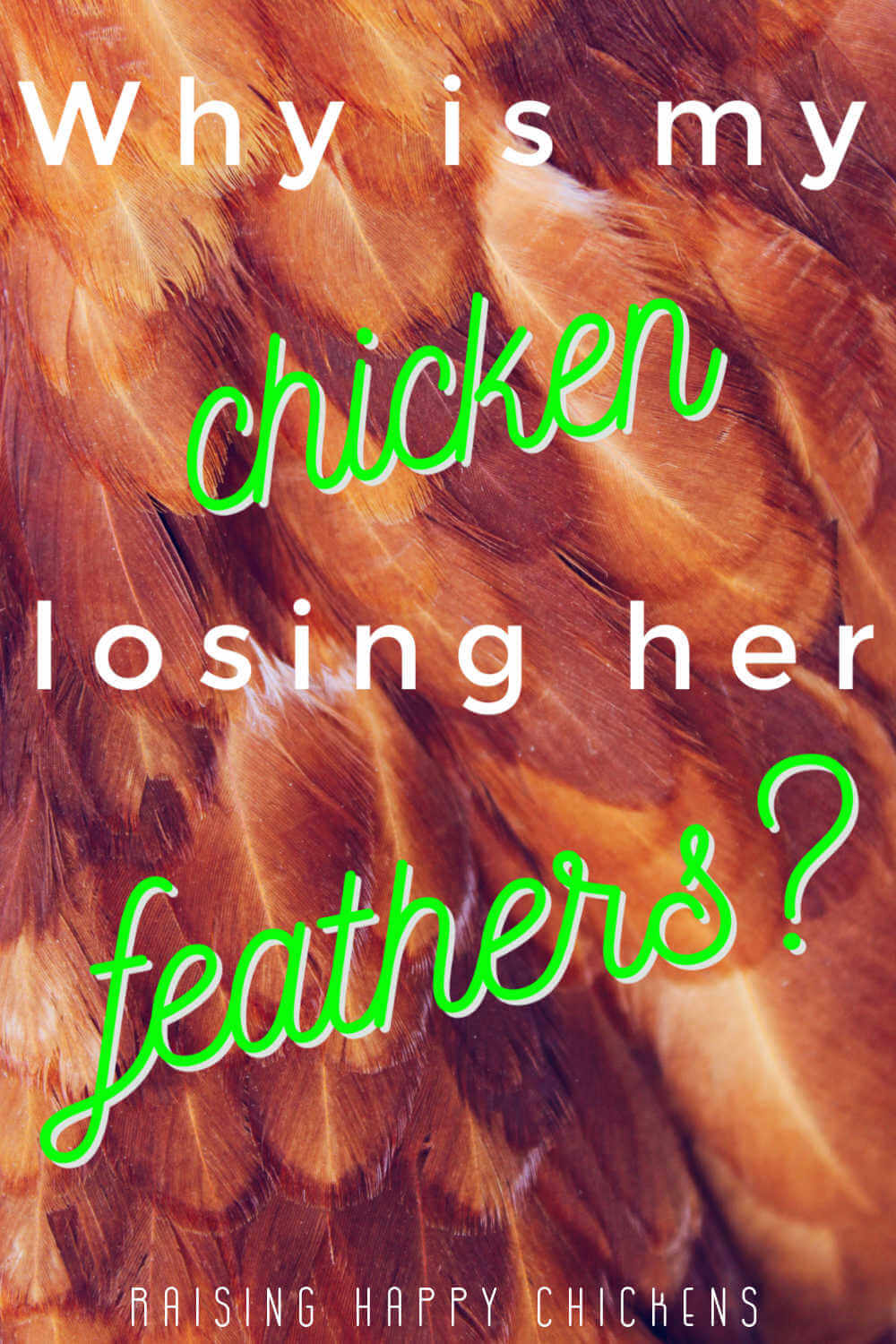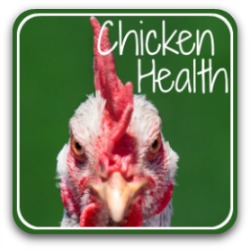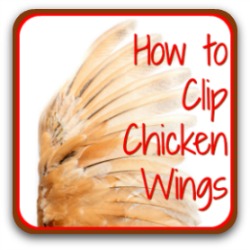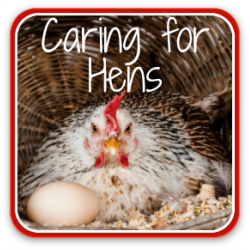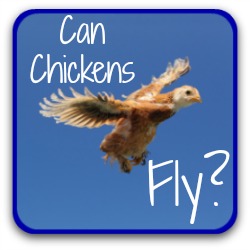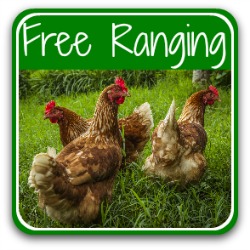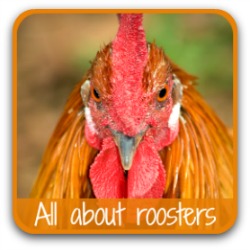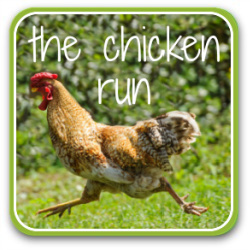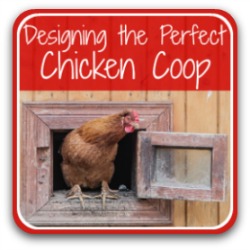Why is my chicken losing feathers? 7 common causes explained.
Please note: This page is written as general information only. It is not intended as medical or veterinary advice and should not be taken as such.
If you're worried about your chickens' health, you should always see your veterinarian.
Suddenly, your chicken run looks like someone’s ripped open a feather pillow, and your once well-dressed flock now looks half-plucked. It can be alarming the first time you see it – but don’t panic!
Most feather loss has a simple explanation, often just related to a normal stage in a chicken’s life. At other times it can signal stress, pests, or health problems that need a closer look.
In this guide, I’ll take you through the seven most common reasons chickens lose feathers, with clear signs to watch for and straightforward fixes you can try.
🪶 Featherlight Takeaways.
Quick insights from this article – especially helpful if you’ve suddenly found feathers everywhere and aren’t sure whether or not you need to worry.
- Moulting is the #1 cause of feather loss and usually nothing to worry about.
- Stress, illness, or parasites can also trigger sudden feather loss.
- Feather-pecking often points to boredom, lack of protein, or bullying in the flock.
- Location matters: back, vent, neck, or chest bald spots each have different causes.
- Feathers do grow back, but pin feathers are delicate, so handle with care.
Best explanation if feathers are missing everywhere.
Previously beautiful chickens look generally scruffy and unkempt.
The most common reason for this is simple: chickens moult their feathers once a year, usually in the autumn (fall).
It’s nature’s way of shedding old plumage and growing new, glossy feathers ready for winter.
I have a detailed article about moulting, here.
But if your flock looks scruffy and it's not autumn, check other possible causes:
🪶 Re-homed ex-battery (caged) hens often arrive with poor feathering after life in cramped cages and on poor-quality feed.
🪶 Fowl pox can sometimes trigger extreme feather loss.
🪶 Stress (for example from predators or extreme heat) may also cause a sudden moult.
Solution:
- The annual moult is normal, so don’t worry about it. Supporting your flock with extra protein can help regrowth.
- Ex-battery hens need special TLC; the British Hen Welfare Trust has excellent guidance.
- Prevent predator stress before it happens by securing your run, and learning about protecting from whichever predators are common in your area.
- Keep your flock cool with frozen treats in hot weather.
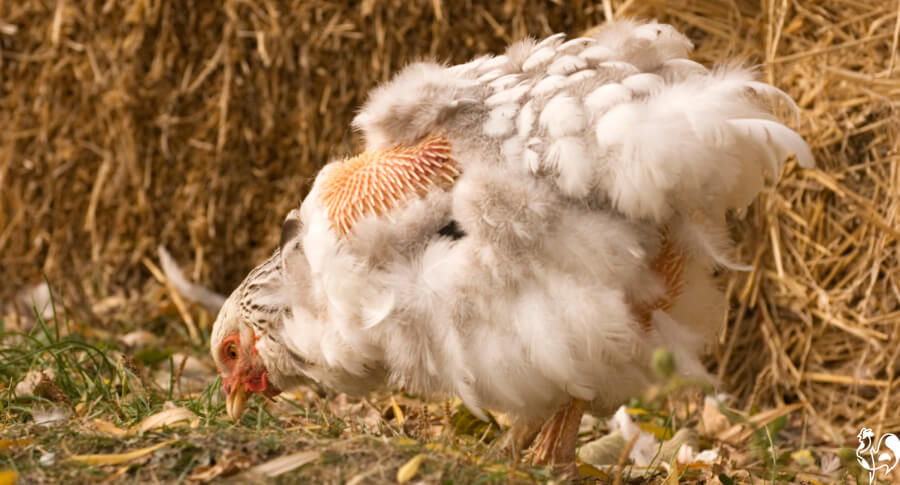 One of my normally beautifully feathered Light Sussex hens, partway through the autumn moult.
One of my normally beautifully feathered Light Sussex hens, partway through the autumn moult.Best explanation if chickens are plucking their own feathers.
Preening is normal, and a perfectly healthy behaviour. Chickens keep their plumage healthy naturally by pulling dirt from their feathers and spreading protective oils. This is a self-care activity, and nothing to worry about.
But feather plucking is different. It’s a behavioural problem, and a warning sign.
Often it’s a re-directed behaviour(2): if chickens don’t have enough food to peck at, or if their diet does not contain enough protein, they’ll turn to each other’s feathers.
Sometimes, it escalates into plain aggression: chickens can bully flock members lower in the pecking order – and they're often ruthless with newcomers.
If you see your chickens actively pecking out each other's feathers, you need to take action immediately.
Solution:
- Make sure your flock has plenty of clean bedding in the coop and nest boxes, and ground cover to forage through in the run.
- Make sure they have a good quality chicken feed. If you see continued feather-picking, offer a high-protein treat: my Poultry Protein Platter recipe is a quick fix.
- If you’ve got a bully, isolate her until she calms down. Here's how to isolate a chicken safely.
If you purchase a product through links on this page, I may receive a small commission at no extra cost to you. I only recommend products I have bought (or would buy) myself, and which I believe will genuinely benefit you. You can read my full disclosure policy here.
Best explanation if your chicken has a bare, red bottom.
Missing feathers and a red, swollen vent usually point to one of three things:
- Red mite infestation.
- Feather-pecking by other hens.
- Vent gleet, a fungal infection often linked to mouldy feed or an infection if there's broken skin. You'll find no (or dirty) tail feathers, a red bottom, often swollen, a yellowish-white discharge – and a disgusting smell...
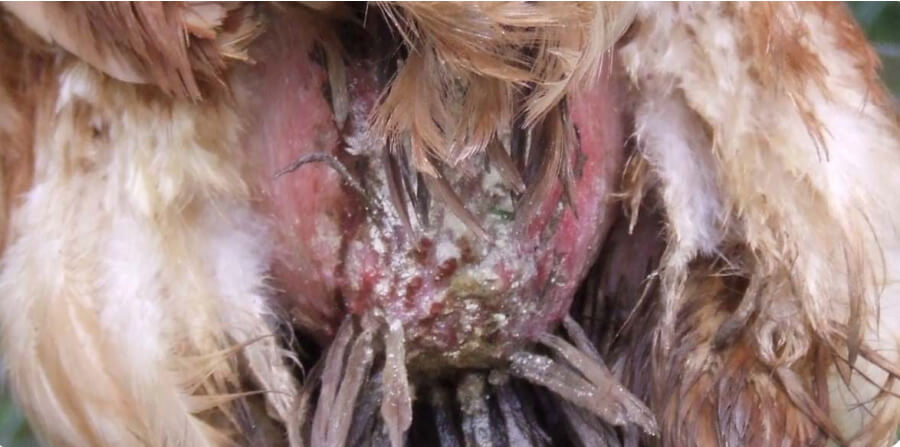 The tell-tale signs of vent gleet: no / dirty feathers and a red bottom. Image courtesy of the British Hen Welfare Trust.
The tell-tale signs of vent gleet: no / dirty feathers and a red bottom. Image courtesy of the British Hen Welfare Trust.Solutions:
- Check your flock regularly for red mite. Find out how in this article.
- See this section for solutions to feather-pecking.
For vent gleet:
- Dissolve two tablespoons of unscented Epsom salts in half a bowl of water and stand the chicken in it for about ten minutes.
- Dry gently, using a towel or low hairdryer setting.
- Apply antifungal cream – keep some in your chicken first aid kit.
- Repeat every two days until it clears. If redness persists, isolate her and apply Blue Kote to disguise exposed skin.
Best explanation if tail feathers are missing.
🐥 A note from my flock: a hen without her tail feathers is a sorry sight...
When one of my Wyandottes went through this stage, she looked so unlike her usual glamorous self, shuffling about with no tail.
But within a few weeks those pin feathers pushed through, and before long she was back to her usual elegant self.
It’s a good reminder that patience (and a bit of extra protein) really does pay off.
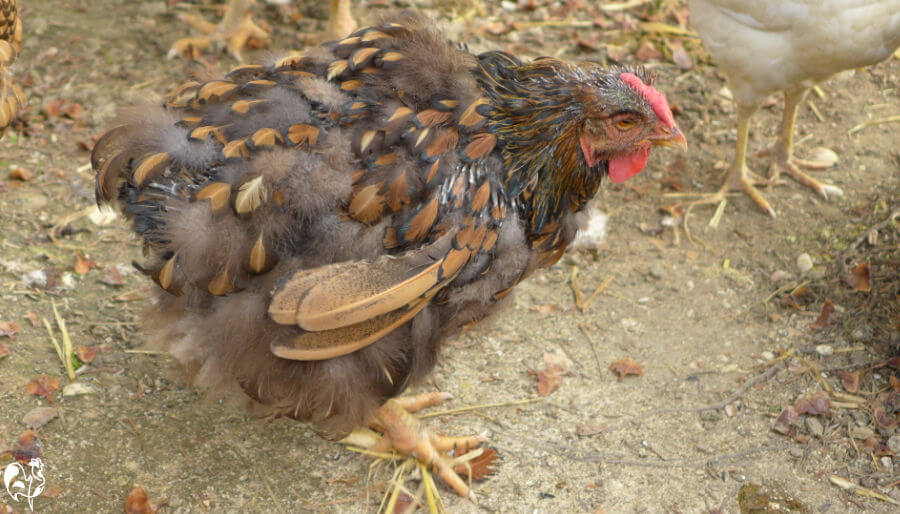 One of my Wyandotte hens looking very sorry for herself having lost her tail feathers.
One of my Wyandotte hens looking very sorry for herself having lost her tail feathers.But this one’s usually nothing to worry about: it’s part of the normal annual moult. Pin feathers (the quills) soon follow, growing into a new tail.
This is the same hen, showing the new "pin feathers" which will soon grow into her usual lustrous tail.
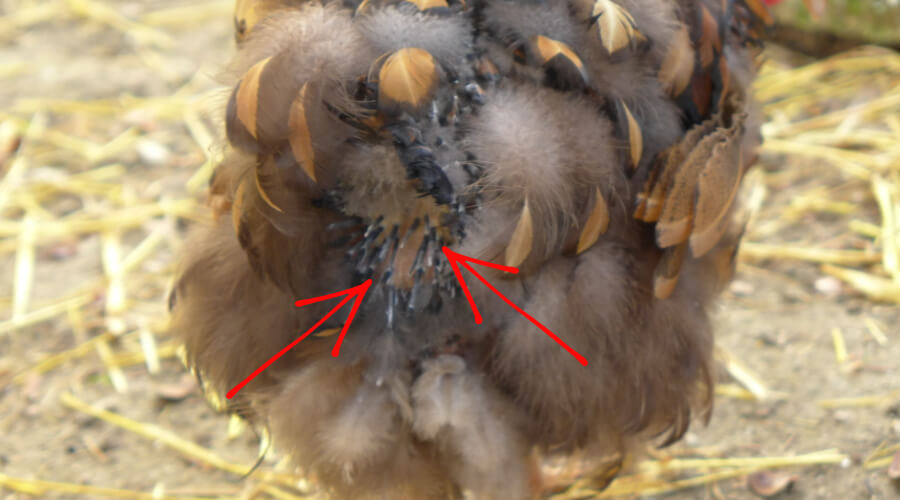 Pin feathers are starting to grow the hen's tail back again.
Pin feathers are starting to grow the hen's tail back again.Solution:
- Boost their diet with extra protein while the feathers regrow.
- Pin feathers are extremely sensitive. Try not to touch them while they're growing back.
Best explanation if feathers are missing on the back.
If your hen suddenly has bald patches on her back, the culprit is usually a rooster (UK: cockerel).
When a male mates, he grips the base of the hen's neck, and treads on her back and sides with his spurs. The typical result is a loss of feathers in a patch on her back, near the tail feathers, and sometimes her sides.
🐥 A note from my flock: my poor Marans looked very sorry for herself after too much attention from Spartacus the rooster: bare back, ruffled feathers, the lot.
A simple hen saddle gave her protection, and before long those feathers grew back glossy and strong.
Sometimes the smallest tweak makes the biggest difference.
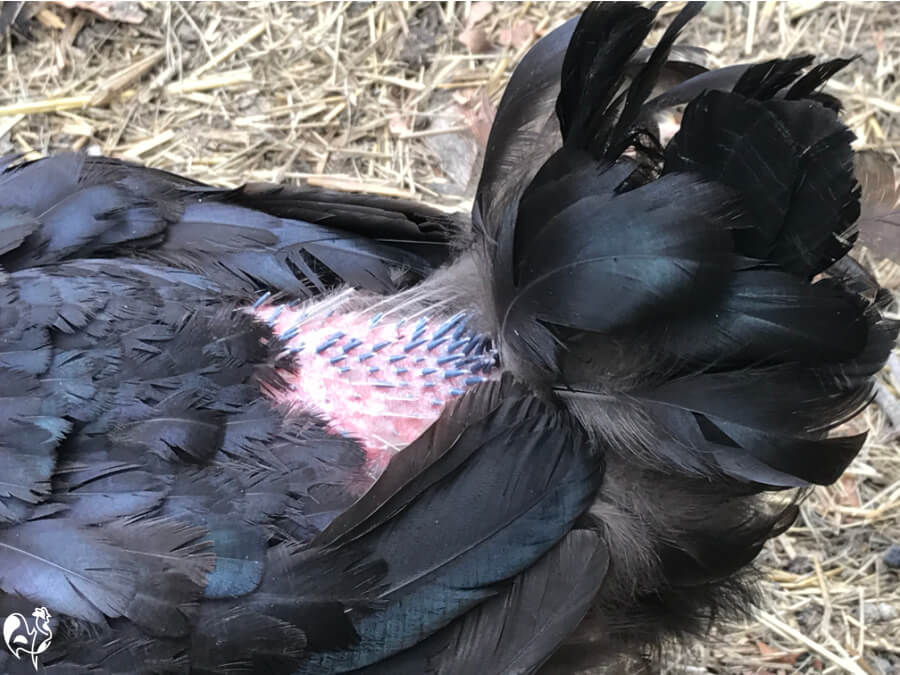 Typical pattern of feather loss on one of my Black Copper Marans hens, due to over-use by a male.
Typical pattern of feather loss on one of my Black Copper Marans hens, due to over-use by a male.Solution:
- Males often favour one or two hens in the flock. If one hen is being over-used, give her a break by isolating her until the feathers grow back.
- Or isolate the rooster. After all, he’s the problem!
- A hen saddle (also known as an apron) is a handy bit of kit that protects her back from further damage.
Best explanation if your chicken looks bald around the head or neck.
There are two main reasons why your chicken may be missing feathers here:
- Naked neck breeds: some breeds (like the Turken) naturally grow without feathers on their necks. If you don’t see feather shafts (pin feathers) trying to regrow, this may just be their normal look.
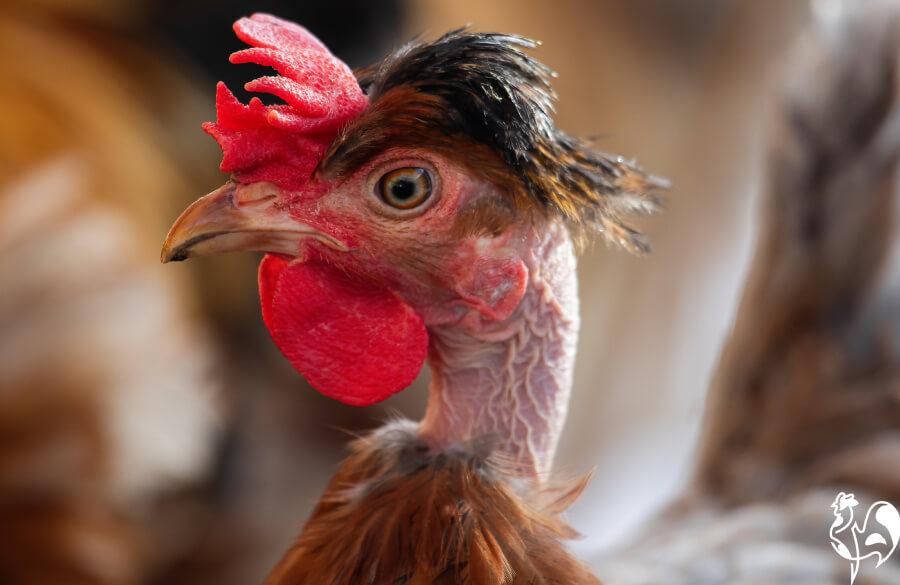 This is a naked neck chicken - there are no feathers on her neck.
This is a naked neck chicken - there are no feathers on her neck.- Over-attentive roosters: as above, during mating roosters often grip neck feathers with their beak. Frequent mating can cause bald spots.
Solution:
- If bare skin looks red, protect it to avoid further pecking from the flock. A purple antiseptic spray like Blue Kote hides the redness and allows feathers to grow back safely.
Best explanation if your hen looks bare-breasted.
Usually nothing to worry about. A broody hen who is incubating eggs pulls out her own chest feathers so her warm skin can sit directly on the eggs. This naturally keeps them at the right temperature and humidity for hatching.
Solution:
- If you don’t want your hen to hatch chicks, you’ll need to break her broodiness by isolating her or using other methods to cool her off.
- Otherwise, no action is needed. Once her chicks are raised, the feathers will grow back naturally.
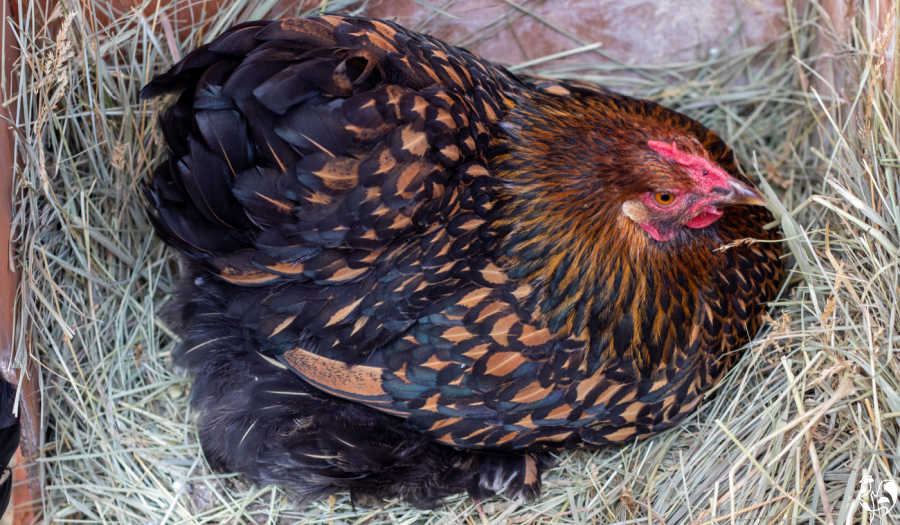 A broody hen will lose her chest feathers so she can properly incubate her eggs.
A broody hen will lose her chest feathers so she can properly incubate her eggs.Do chicken feathers grow back?
Yes. Chickens regrow feathers naturally after moulting, bullying, mating wear, or other causes of feather loss.
You’ll notice short “pin feathers” emerging first. These look like little quills with a white sheath, and as they grow, the soft feather unfurls from the tip.
In tis photo, one of my Wyandottes is growing her feathers back after a moult. You can clearly see the feathers emerging from the top of the quill (where the arrows are).
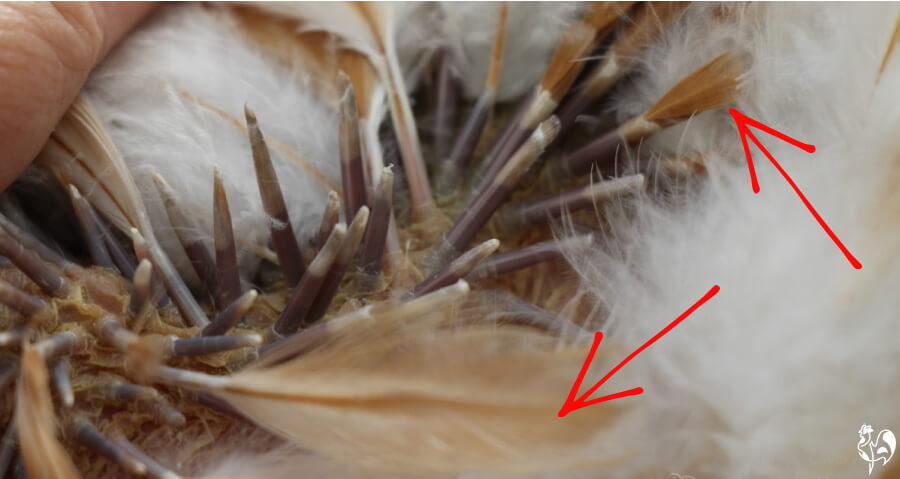
It’s important to remember:
- Feathers always regrow unless the follicle itself has been permanently damaged (which is rare).
- Pin feathers are sensitive and can cause pain if handled, so avoid picking up your chicken unless really necessary.
- Timing varies. Re-growth after moulting usually takes between 6 and 12 weeks, while after damage (for example, over-mating) it may take longer.
- If you’ve clipped a chicken’s wings for safety, those feathers will also grow back after the next moult, so you’ll need to repeat the clipping.
Frequently Asked Questions about chickens losing feathers.
Still worried about feather loss? Here are a few quick FAQs covering the questions I hear most often from other chicken-keepers.
Is it normal for chickens to lose feathers once a year?
Is it normal for chickens to lose feathers once a year?
Yes. Annual moulting is completely normal in most breeds, usually in the autumn. It can look alarming, but it's simply nature’s way of replacing old plumage.
What causes chickens to pick at each other’s feathers?
What causes chickens to pick at each other’s feathers?
Feather-pecking is usually a sign of behavioural problems. Common causes include low protein diets, overcrowding, boredom (lack of foraging), or a dominant hen bullying others.
Do chicken feathers grow back?
Do chicken feathers grow back?
Yes, feathers almost always grow back.
You’ll first see "pin feathers" emerging from the quill. These are sensitive, so avoid handling until the new plumage has developed.
After a full moult, clipped wings also regrow and will need trimming again.
My chicken is puffed up. Is that the same as feather loss?
My chicken is puffed up. Is that the same as feather loss?
Not usually: it is more likely to be completely normal behaviour.
Chickens fluff their feathers to keep themselves or their chicks warm, or protect themselves (particularly their feet) from frostbite.
But if a puffed-up bird looks drowsy, hunched, or unresponsive, it can signal illness. In that case, investigate further.
Other chicken health articles.
Sources and further reading.
A lot of "facts" you'll find on the internet are often people's individual views, based on inaccurate information repeated from poor quality sources.
The information I provide in this article and others is based not just on my own experience, but on evidenced facts from scientific, peer-reviewed research and books from highly respected and experienced poultry keepers such as Gail Damerow.
Some of the trusted sources I have used in this article are these.
1. The British Hen Welfare Trust is an excellent source of information and support for anyone adopting ex-battery hens.
2. Sedlačková, M: Feather Pecking in Laying Hens: Environmental and Endogenous Factors. Pub. Institute of Animal Biochemistry and Genetics, 2004.
